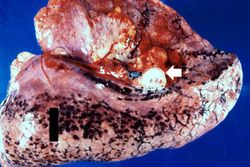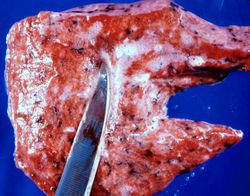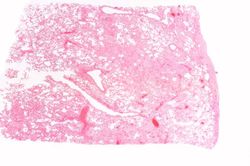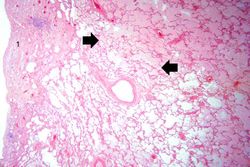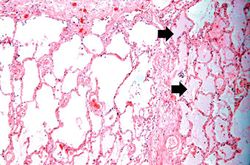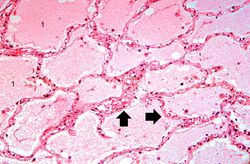Difference between revisions of "IPLab:Lab 4:Pulmonary Congestion and Edema"
| Line 17: | Line 17: | ||
File:IPLab4PulmonaryCongestion7.jpg|This high-power photomicrograph illustrates the edema fluid within the alveoli (1) and the congestion (RBCs) in the alveolar capillaries (arrows). | File:IPLab4PulmonaryCongestion7.jpg|This high-power photomicrograph illustrates the edema fluid within the alveoli (1) and the congestion (RBCs) in the alveolar capillaries (arrows). | ||
</gallery> | </gallery> | ||
| + | |||
| + | == Study Questions == | ||
| + | * <spoiler text="Name two types of edema fluid.">Inflammatory edema has a higher protein content (specific gravity > 1.020) and is associated with an inflammatory reaction. | ||
| + | |||
| + | Noninflammatory edema is caused by alterations in hemodynamic forces across the capillary wall (hemodynamic edema).</spoiler> | ||
| + | * <spoiler text="Define the following: | ||
| + | # anasarca">Anasarca: severe and generalized edema which includes marked swelling of the subcutaneous tissues.</spoiler> | ||
{{IPLab 4}} | {{IPLab 4}} | ||
[[Category: IPLab:Lab 4]] | [[Category: IPLab:Lab 4]] | ||
Revision as of 14:24, 21 August 2013
Clinical Summary[edit]
This 69-year-old white male with well-controlled Type I diabetes mellitus (insulin-dependent) presented with upper abdominal and lower chest pain of four hours duration and accompanied by shortness of breath and diaphoresis. An electrocardiogram revealed multiple premature ventricular contractions (PVCs). The hospital course was characterized by recurrent pulmonary edema and oliguria. The terminal event was cardiac arrest.
Autopsy Findings[edit]
Significant findings at postmortem examination were old and recent myocardial infarctions and evidence of congestive heart failure. The right and left lungs weighed 950 grams and 750 grams, respectively, and were reddish-brown.
Images[edit]
Study Questions[edit]
| |||||
Shortness of breath is a common clinical manifestation of heart failure.
Diaphoresis is a profuse perspiration often seen during a myocardial infarction.
Premature ventricular contractions (PVCs) are a common cardiac arrhythmia. They are present even in healthy individuals, for whom no treatment is indicated. However, in patients with heart disease, PVCs can be significant indicators of disease processes. For example, increased numbers of PVCs are common following an acute myocardial infarction.
Pulmonary edema refers to the accumulation of fluid in the pulmonary alveolar and tissue spaces as a result of changes in capillary permeability and/or increases in capillary hydrostatic pressure.
Oliguria is the occurrence of decreased urine output.
Cardiac arrest is the sudden standstill of cardiac function.
A normal right lung weighs 450 grams (range: 360 to 570 grams.
A normal left lung weighs 375 grams (range: 325 to 480 grams).
Pulmonary congestion is the engorgement of pulmonary vessels with blood. The increased pressure caused by this engorgement leads to transudation of fluid through the capillary walls and into the alveolar and interstitial spaces.

